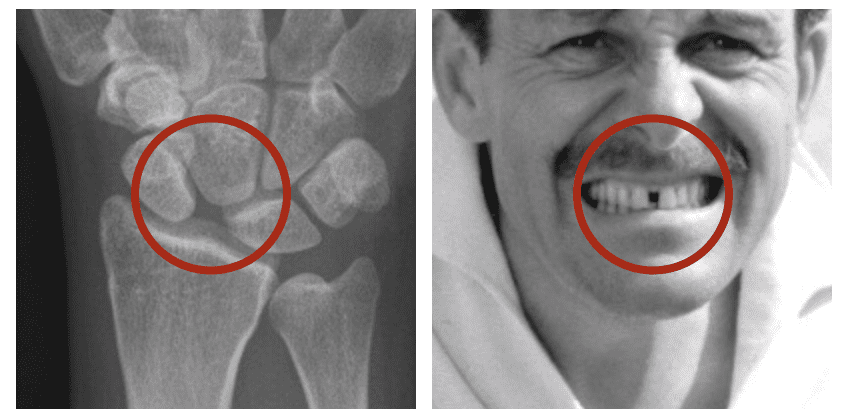Terry-Thomas Sign
Description
Terry-Thomas Sign: increased distance between the scaphoid and the lunate (scapholunate space) on AP XR of the wrist associated with scapholunate dissociation. Frankel in 1977, likened the widening of the scapholunate interval to the ‘upper central dental diastema‘ of British comedian Terry-Thomas
Scapholunate dissociation is associated with scapholunate ligament disruption; scaphoid subluxation, rotation and potential carpus instability
The scapholunate interval (measured at the midpoint of the adjacent parallel articular contours of the scaphoid and lunate bones) should be <2mm and scapholunate dissociation (Terry-Thomas sign) most commonly described for intervals >4mm
With scapholunate dissociation, the scaphoid often rotates to a more transverse position increasing the scapholunate angle to more than 60° and if rotated to be viewed end-on the ‘signet-ring sign‘ occurs
History of the Terry-Thomas Sign
1977 – Victor H Frankel, MD proposed and sought permission from the actor Terry-Thomas that his name and physiognomy be used eponymously
The application of anthropomorphic similes can aid in the recognition of conditions that are difficult to diagnose and easily overlooked. Dental diastema (the classic Terry-Thomas dental pattern) is a useful anthropomorphic sign for detecting rotatory luxation of the navicular (scaphoid).
Frankel VH, 1978
Associated Persons
- Terry-Thomas (1911-1990)
Alternative names
- David Letterman sign
- Scapholunate dissociation
- Rotary subluxation of the scaphoid
- Rotational subluxation of the navicular
Controversies
Dr. Frankel graciously obtained the actor’s permission before naming a pathological entity after him. Although first eponymised in 1977, by Victor H Frankel (1977;129:321-2) – this reference had numerous errors and was reprinted with correction in 1978 (1978;135:311-2)
The application of anthropomorphic similes supplies us with diagnostic clues and triggers that simplify the complicated and clarify the opaque –
Frankel VH, 1978
Alternate Carpal bone nomenclature
Bones of the carpus have had many names over the centuries. Frankel described the ‘rotational subluxation of the navicular, resulting in a gap between the navicular and lunate with similar appearance to the dental diastema of Terry-Thomas‘. In the same paper Frankel described the mnemonic for bones of the carpus as ‘Never Lower Tillie’s Pants, Grandma May Come Home.‘ – this may appear confusing…until modern nomenclature is applied
- N = Navicular (now scaphoid); L = lunate; T = triquetrum; P = pisiform
- G = Greater multangular (now trapezium); L = Lesser multangular (now trapezoid); C = cueiform; H = hamate
References
Original articles
- Frankel VH. The Terry-Thomas sign. Clin Orthop Relat Res. 1977 Nov-Dec;(129):321-2.
- Frankel VH. The Terry-Thomas sign. Clin Orthop Relat Res. 1978 Sep;(135):311-2.
Review articles
- McKennedy C. Terry-Thomas sign. Eponym A Day. Instagram
- Neill A. Scapholunate dissociation. In: Anatomy for Emergency Medicine 018. EM Ireland 2012.
- Clark DL, von Schroeder HP. Scapholunate ligament injury: the natural history. Can J Surg. 2004 Aug;47(4):298-9
- Linscheid RL, Dobyns JH, Beabout JW, Bryan RS. Traumatic instability of the wrist. Diagnosis, classification, and pathomechanics. J Bone Joint Surg Am. 1972 Dec;54(8):1612-32.
- Berger RA. The gross and histologic anatomy of the scapholunate interosseous ligament. J Hand Surg Am. 1996 Mar;21(2):170-8.
- Cadogan M. Terry-Thomas sign. Eponym A Day. Instagram
[cite]
eponymictionary
the names behind the name

